Fig 1. Mutations counted at strong nucleosome core particle DNA positions.
(A) DNA wraps around the nucleosome histones (shown as blue circles), with the least accessible region near the dyad and the most accessible regions near the edges of the nucleosome (nucleosomes consist of 8 histones and almost 2 complete DNA wraps, but only 4 histones and most of 1 wrap is shown here for simplicity). The linear positioning of the DNA along the nucleosome is the translational setting. As the DNA rotates around the nucleosome, bases proximal to the histones are termed “inward” facing, while those that are distal are called “outward” facing. The inward bases experience less mobility due to the increased interactions with the histones, whereas the outward bases have greater mobility. Hence, the DNA’s rotational setting causes some bases to have higher and lower mobility. (B) Observed single nucleotide substitutions and expected mutations (solid lines) based on sequence context were counted at individual base pairs across nucleosome positions. Grey dashed lines indicate the outward rotational setting of the DNA, occurring every 10.3 bp. (C) The periods in the observed and expected mutations were quantified by Lomb-Scargle analysis. (D) Observed mutations normalized to the expected mutations (i.e. mutation enrichment) displays an emphasized ~10 bp periodicity as well as a “negative” curvature across the nucleosome. We represent this curvature mathematically by fitting the enrichment data to a second order best-fit polynomial [by the formula y = ax2 + bx + c] (dashed blue line). (E) Neither observed nor expected mutations at weakly positioned nucleosomes showed an obvious pattern. (F) The periodogram shows a slight peak at ~10 bp, which is less than half as strong as the peak observed in strongly positioned nucleosomes (Fig 1C). (G) The enrichment of observed to expected mutations at weakly positioned nucleosomes also does not show a significant pattern, and the curvature is inversed.

